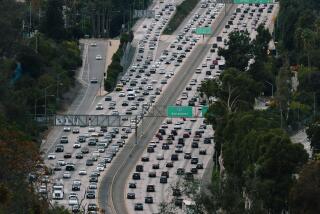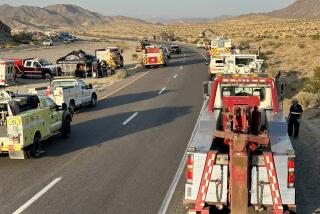Bad Luck From Las Vegas as Traffic Slows on I-15
- Share via
Massive traffic jams on Interstate 15 have been trapping Los Angeles-bound motorists returning from weekends in Las Vegas, according to the Nevada Department of Transportation. Round-the-clock construction on the four-lane highway is being blamed for the 4- to 8-mile-long slowdowns that have been occurring during peak 2-9 p.m. Sunday travel time. The road work--which began in August on both the north- and southbound sides--has reduced traffic from two lanes in each direction to one along a 16-mile stretch north from the California/Nevada border. It reportedly is adding about an hour to southbound Las Vegas-to-Los Angeles travel time on Sundays; the northbound section is experiencing only minor slowdowns on Friday nights--the peak period for L.A.-to-Nevada travel. However, on three-day weekends, including this Columbus Day weekend, construction is being halted from noon on Friday until the following Tuesday. For the Thanksgiving weekend, it will be suspended at noon the Wednesday before Thanksgiving and remain so until Monday, according to a Department of Transportation spokesman. If the project continues on schedule, construction will be limited to weekday business hours beginning in February. For now, alternate routes include taking U.S. 95 south out of Las Vegas to Needles, then Interstate 40 west to Barstow to rejoin I-15. Or U.S. 95 south to Searchlight, then Nevada 164 west to the I-15 junction about 10 miles into California.
*
Travel Quiz: In what state was the westernmost battle of the Civil War?
*
Colosseum Takes a Bath: Rome’s landmark Colosseum is getting an overdue face lift to remove centuries of grime, according to a report filed by The Times’ Rome correspondent, William Montalbano. The $32-million cleanup, sponsored by the private Banca di Roma, is expected to take four years, during which time the old arena will remain open to visitors. Scaffolding will be applied a few sections at a time, guaranteeing that there will always be a familiar, scaffold-free profile available for picture-taking. Tourists will be allowed to examine the high-tech restoration, which began with systematic inspection of the Colosseum to analyze the damage of the ages, compounded by big-city pollution. In addition to cleaning, restorers plan to drain and clean blocked underground water channels to reinforce the foundations of a structure shaken over more than 20 centuries by everything from chariots to earth tremors to cars and buses.
*
Quick Fact: In 1991, travel spending in the United States averaged $926 million per day, $38.6 million per hour, $643,000 per minute or $10,700 per second. (Source: U.S. Travel & Tourism Administration and U.S. Travel Data Center.)
*
Fewer State Department Advisories: In an effort to simplify what has become a long list of travel advisories--ranging from notices designed to make travel easier to warnings of potentially life-threatening situations--the U.S. State Department’s Consular Affairs office has decided to significantly reduce the number of advisories it issues. Henceforth, it will reserve advisories for warnings about situations that could put the traveler at risk. To replace other information contained in the more than 100 State Department advisories recently on file, the department will issue travel warnings and fact sheets on every country in the world. The so-called “consular information sheets” will be more strictly informational, according to a State Department spokeswoman, whereas “the places where we have warnings will be places where we don’t want Americans to go; places where it is really unsafe to travel.” Both the new consular information sheets and the travel warnings are available through the Citizens Emergency Center’s automated answering system (202-647-5225). The information will also be available at U.S. passport agencies, embassies and consulates around the world; through travel agents’ computer reservation systems, and through a number of electronic bulletin board services, including the Consular Affairs Bulletin Board (202-647-9225).
*
New to Latin America: United Airlines has begun flying two new Latin American routes, providing scheduled nonstop service between the major Brazilian city of Sao Paulo and both Los Angeles and Miami. The Los Angeles-Sao Paulo flight with continuing service to Rio de Janeiro will operate three days a week now through Dec. 1, when the service will be upgraded to daily flights. An introductory, 14-day advance-purchase fare of $849 (compared with $1,350 for normal lowest round-trip fare this time of year) is being offered for round-trip travel between Los Angeles and either Sao Paulo or Rio by Nov. 30.
*
Ringing Up Rosarito: The Convention & Visitors Bureau of the ocean-side resort of Rosarito, in Baja Norte, Mexico, has just begun operating a toll-free information number to provide travel tips, in English, on hotels, restaurants and activities in the Rosarito area (800-962-BAJA; in San Diego, 234-5652). Callers can also request a free 24-page guidebook that describes such activities as the Lobster Festival next Sunday, Oct. 18, in Puerto Nuevo Lobster Village.
*
Adventures in Latte Land: Only in Seattle would there be a festival honoring the coffee bean or, rather, the cult, culture and assorted paraphernalia associated with the bean. Coffee Fest-Seattle Style, Nov. 20-22, will offer opportunity to sample a wide variety of coffees and become fluent in the differences between cappuccino, cafe latte and espresso, as well the nuances of roasts and grinds from experts in the field. Admission is $6 to the event at Seattle Center’s Northwest Rooms.
*
Comparatively Speaking: Countries that spent most on promoting tourism in 1990 (in millions): Italy, $1,169.2; Spain, $256.7; France, $196.1; Korea, $158.5; Mexico, $97.8; Greece, $94.1; Austria, $61.4, and Singapore, $56.9. The United States was No. 20 with $14.3. (Sources: World Tourism Organization; Travel and Tourism Government Affairs Council.)
*
Quiz Answer: In Arizona, at what is now Picacho Peak State Park, about 35 miles north of Tucson, the Battle of Picacho Pass occurred on April 15, 1862.
More to Read
Sign up for The Wild
We’ll help you find the best places to hike, bike and run, as well as the perfect silent spots for meditation and yoga.
You may occasionally receive promotional content from the Los Angeles Times.






